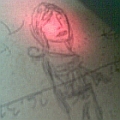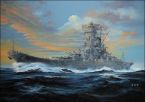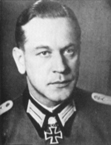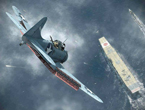Voltreffer
Posts: 32
Joined: 2/13/2020
From: Los Angeles
Status: offline

|
quote:
ORIGINAL: Yaab
Seems to me I would be more beneficial to have four twin mounts and shoot at four targets, than have two quads mounts and shoot at two targets. Any thoughts?
Let's take your hypothetical to explore the issue: four twin mounts shooting at four targets vs. two quad mounts shooting at two targets; in each case, we have an equivalent eight barrels.
When designing shipboard AA defenses, maximize the number of targets which can be engaged effectively at the same time. This is a relatively simple phrase which masks a lot of complexity.
In terms of WW2, the number of targets that can be simultaneously engaged is a 1:1 ratio to the number of fire directors onboard (whether each fire director is a person or some combo of personnel and equipment). "Engaged effectively" involves a comparison of the weapon system(s) used vs. the threat(s) faced.
It is important to remember the primary purpose of AA defenses is to prevent a successful attack, NOT to destroy the attacker. Destroying the attacker is a happy side effect only; thus, "engaged effectively" is defined as such (if you doubt this, think of it in terms of the Kamikaze). Preventing the attack involves disrupting the targeting solution and/or damaging/destroying the aircraft early enough that they are unable to complete the attack.
Bringing it back to your hypothetical - the only way the four twin mounts shoot four targets simultaneously is by having four fire directors. If the weapons in question were very effective individually at disrupting attacks, this could be a desirable configuration. In terms of missiles, this translates to active radar-guided missiles (i.e. each missile possesses its own 'fire director' and thus can be independently deployed).
Since WW2 AA weapons weren't quite at that point yet, I think a more meaningful comparison would be the four twins vs. the two quads, in each case them being directed by two fire directors; thus, each configuration can engage two targets. These configurations might seem equivalent: eight barrels total of the same gun engaged with a maximum of two targets at a time. This evaluation, however, leaves out two closely-tied considerations: weight and space (on the ship).
The quad mount is essentially two twin mounts in close proximity to one another so they can share blast shielding, ammunition sources, and a common mount. It's the configuration of these equipment 'accessories', if you will, where the weight and space savings are realized. When you consider how much the 'two twins' of a quad mount are able to share, the only advantage of two separate twin mounts is they are able to train (move) independently, yet this advantage becomes moot unless one is willing to spend the additional weight on another fire director; otherwise, these two 'independent' mounts can only effectively fire at one target anyway.
Then let's consider that AA in WW2 is very much "accuracy through volume". Without super accurate fire direction, the best way to ensure 'hits' is to throw up as much lead as possible in the general direction of the target (but still striving for the greatest degree of accuracy possible). Any given ship design is going to have only so much weight and space set aside for AA equipment, where equipment is inclusive of fire direction, ammunition storage/handling, crew/equipment protection, and the appropriate structure(s) to place said equipment in their most effective possible locations. Not to mention the weight of the necessary AA crew themselves along with their provisions, bunking, etc. All this weight/space does add up, especially when one considers that the ideal location for AA equipment is often high up on a ship, as higher typically means less obstructions for better field of fire and better spotting/targeting. Even a relatively small amount of weight placed high up on a ship can significantly affect its seakeeping abilities (i.e. stability of the ship, especially in rough seas and/or maneuvering... such as when the ship is trying to dodge aerial attacks).
It is then easy to see then that the path towards maximizing AA effectiveness in this context is by utilizing all available space/weight and maximizing the weight/space savings for each gun (i.e. more 'stuff' in the same sized bag).
All that said...
It's ironic that the 40mm Bofors was deployed in such a way to be effective enough (as part of a larger overall solution involving the 5" guns as well as CAP, radar, C/C, etc.) to effectuate its own obsolescence. Improvements in the number and quality of AA equipment along with commensurate improvements in fighter protection caused BOTH the US Navy and the Imperial Japanese Navy to change tactics. For the US Navy, the calculus of dividing carriers into separate task forces as seen in the earlier battles changed into the massed fast carrier task forces as seen in the later battles. The defenses became so effective that the US Navy stopped caring that the Japanese could find all the carriers with a single spotting - the massed task force had become nearly impenetrable to the conventional aerial attack. The Japanese, of course, responded with the Kamikaze as it was still possible to reach valuable targets IF one was no longer concerned with returning from the battle. And thus the 40mm shell fired en masse, which could be great at dissuading an attacker who ideally wanted to go back to base later that day, suddenly became insufficient to completely stop the careening mass of a diving Kamikaze. Even though it wasn't a perfect weapon for the Kamikaze, it's what the US Navy had at the time... so again, the answer was to install even more of them. These are the refits we see in particular in late '44, early '45. The ultimate solution (to supplement the existing excellent 5"/38 guns which were far heavier thus fewer in number) which didn't arrive anywhere close in time for the war was the development of the automatic 3"/50 gun which eventually saw service in the late 40s. It fired a 12 lbs. (5.44 kg.) shell as compared to the 40mm Bofors' 2 lbs. (0.9 kg.) shell, was automatically loaded, and the shell was large enough to accommodate a VT (proximity) fuse, which greatly increased the accuracy of AA fire as was seen during the war with the 5" guns. The 40mm Bofors shell was too small to accommodate a VT fuse:

Source: Naval Weapons of World War II (US Naval Institute Press)
As a final side note, the plethora of AA guns on US Navy ships was largely due to Admiral Willis "Ching" Lee (most commonly known as a commander of fast battleships), along with the backing he received from Admirals King and Nimitz. Aside from leaders of nations/navies, it's hard to find peers to Admiral Lee from the context of the wide-ranging impact he had on his service. John Boyd comes to mind for his impact decades later on the Air Force. That said, Lee's continual man-handling of BuOrd is alone the stuff of legend. The fact we're not bemoaning BuOrd today about their botching of US Navy AA defenses during WW2 the same way we bemoan their treatment of torpedoes has a lot to do with Admiral Lee being a certified bad-ass.
The video by Drachinifel on Admiral Lee is highly recommended (I've set it to the point in Lee's career where he begins to significantly affect the entire fleet):
https://youtu.be/58lfaMFUQc0?t=1073
Also, this is an excellent video by the Battleship New Jersey Museum regarding the 3"/50 gun which eventually replaced the 40mm Bofors; these videos do a great job explaining where the US Navy's thinking was regarding AA in late WW2. The war ended before these could be deployed as the answer to Kamikaze attacks:
The Gun NJ Never Got, 3in Guns on USS Salem
https://www.youtube.com/watch?v=FVKLsh71yXw
Another BB New Jersey Museum video about what Adms. King/Nimitz might have done to modify the Iowa class AA defense (most likely on Kentucky / Illinois had they been completed):
King/Nimitz Iowa Conversion
https://www.youtube.com/watch?v=IgDSla04cvA
|
 Printable Version
Printable Version
















 New Messages
New Messages No New Messages
No New Messages Hot Topic w/ New Messages
Hot Topic w/ New Messages Hot Topic w/o New Messages
Hot Topic w/o New Messages Locked w/ New Messages
Locked w/ New Messages Locked w/o New Messages
Locked w/o New Messages Post New Thread
Post New Thread